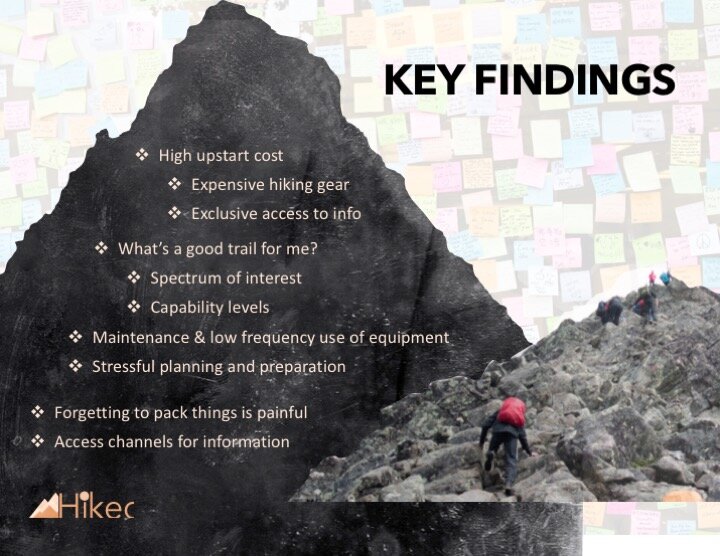Project HIKEO
With the goal of creating an experience that can be prototyped, evaluated, and presented, our team delivered a product & service who’s mission centers around delivering an experience to its customers/consumers using an iterative design process. The experience our team designed and developed for the project is called HIKEO. HIKEO is both a product (UX) and service (SD) designed specifically to be highly-situated within a larger, holistic, end-to-end customer experience (CX) with a central feature of the experience being focused on information design (IX).
This project provided the opportunity to carry out an experience design project from end-to-end, thus simulating a real-world user experience design practices. There were many processes & design tools that were utilized to create HIKEO, all of which can be found below.
As people who love hiking and the outdoors, we quickly realized in our brainstorming sessions that there were many problems we faced when planning for a hike. The entire planning process can often be tedious, stressful, and quite intensive! With that in mind, we identified various problems that too often detract from the overall hiking experience. We first looked internally to gauge where we wanted to start our exploration process. After speaking to our immediate friends, family, and co-workers, we recognized that there were generally three main considerations that were common in planning and preparing for a hike: WHO, WHEN, WHERE.
And when we dug deeper into the questions of “when do you want to go?” or “who do we want to go with?” or ultimately, “where do we want to go?”, we realized that there were logistics coordination, and preferences to be factored in. And when we expanded our scope and looked further outward, we recognized that each of us had our own perspectives on the “when’s”, “who’s” and “where’s” of our individual processes.
Through additional analysis, some of the key findings we came across were that, hiking gear is expensive and the activity itself is somewhat exclusive. The question of “what’s a good trail for me?” was a frequent and difficult question to answer and when personal interests, capabilities, and ultimately one’s confidence level was incorporated, the process became increasingly overwhelming. We also recognized that we often are left with the sole option to buy expensive equipment that requires relatively high maintenance relative to its intermittent use. In the end, the whole planning and preparation process was quite a pain point in and of itself!
Once we were able to gain these insights and perspectives, we consolidated our interviews, online research, and own personal experiences as hikers to refine the concepts on which we wanted to focus on. We recognized there is a definite need for a solution that synthesizes the planning and preparation process, thus leading us to develop our unique value proposition.
Below are samples of the materials produced and documented through the extensive design process to create HIKEO. For more detailed documentation of our design process or our design rationale, please reach out directly.
Field Investigations & Affinity Diagram
Through a process of structured brainstorming and field investigations, our team identified various experiences we could design and create value for our customers. After which, we converged our thinking processes through a constructive dialogue to narrow down and expand our understanding on a specific opportunity that could be crafted and developed upon.
Customer & User Personas
To easily recognize and understand our intended audience for the experience our team was designing HIKEO for, we created both primary and secondary customer/user personas for the application. These personas served as a constant reminder of who our customers were and therefore helped direct all of our design choices through the development process.
Exploring through Experiences: Storytelling
In order to explore and consider HIKEO’s users’ experiences in more detail, our team used the design method: storytelling, to verbally express and dive into the “experience story” from the perspective of our main user persona: Bailey.
















Building a Key Design Scenario
After expressing various different experience stories, we created a key design scenario to precisely describe how our primary user persona in the story would interact with the new technology we were designing. The goal of this key scenario was to provide a realistic, in- context view of a specific use of the HIKEO system, from the user's perspective.
Idea Blueprint & Lean Canvas
To visualize the concept of HIKEO better, a hybrid model of an idea service blueprint was created to aid our team in the process of deciding which features were most important and how the various touchpoints of the HIKEO experience would involve a cross-functional effort. We then also considered the desirability, viability, and feasibility HIKEO and its features using a Lean Canvas to “Big Picture” and map out the various aspects of the organization.
Customer Journey Mapping
To better understand HIEKO’s customers’ expectations, our team mapped out one important aspect of the HIKEO experience using customer journey mapping. This exercise helped to map out HIKEO’s customers’ interactions through a visual story and was critical to our team’s efforts in gaining insights on any common customer pain points, and so, optimizing the overall customer experience in our creation.
Building Wireframes & Evaluations
Once our team had thoroughly considered, developed, and designed HIKEO using all the previous design stages, we were finally ready to create an actual prototype model of HIKEO’s interface and tested it out with potential users to gain additional insights. Using Balsamiq, our team created low-fidelity mock-ups of the HIKEO’s mobile application.




